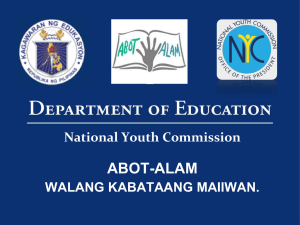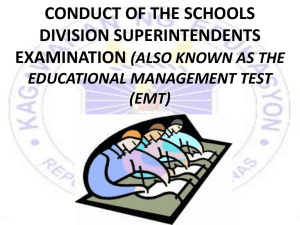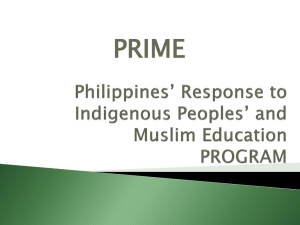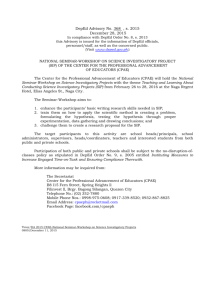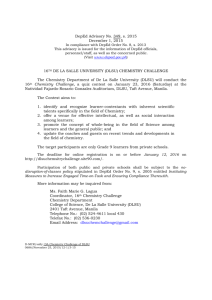to the Word Document Format of this article.
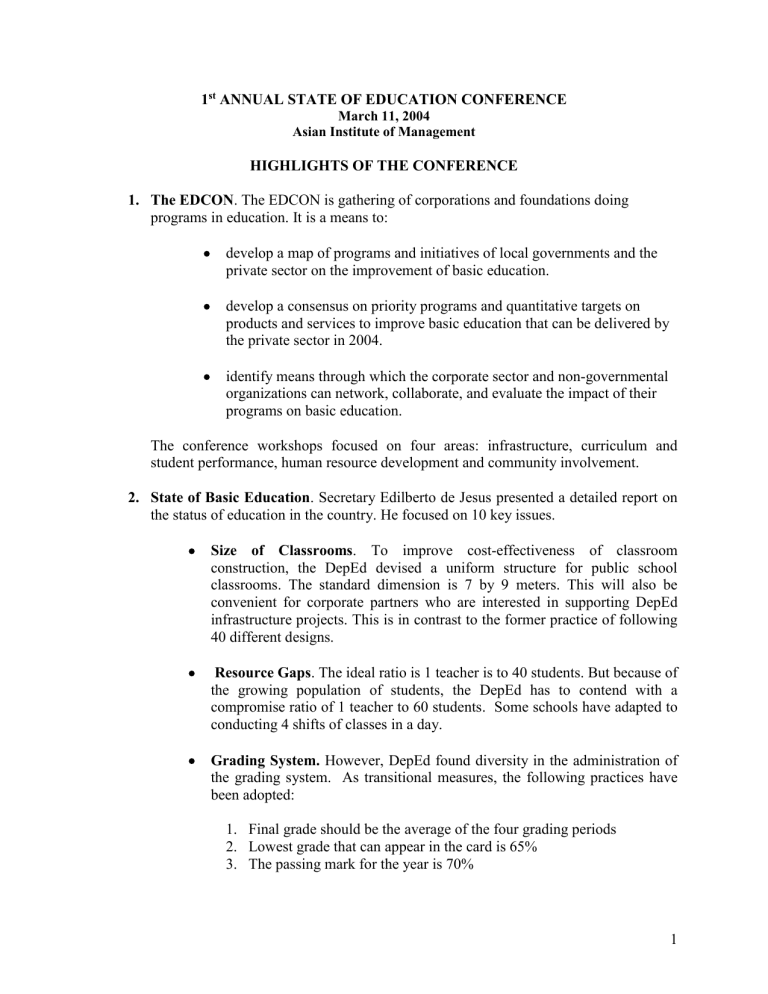
1 st ANNUAL STATE OF EDUCATION CONFERENCE
March 11, 2004
Asian Institute of Management
HIGHLIGHTS OF THE CONFERENCE
1.
The EDCON . The EDCON is gathering of corporations and foundations doing programs in education. It is a means to:
develop a map of programs and initiatives of local governments and the private sector on the improvement of basic education.
develop a consensus on priority programs and quantitative targets on products and services to improve basic education that can be delivered by the private sector in 2004.
identify means through which the corporate sector and non-governmental organizations can network, collaborate, and evaluate the impact of their programs on basic education.
The conference workshops focused on four areas: infrastructure, curriculum and student performance, human resource development and community involvement.
2.
State of Basic Education . Secretary Edilberto de Jesus presented a detailed report on the status of education in the country. He focused on 10 key issues.
Size of Classrooms . To improve cost-effectiveness of classroom construction, the DepEd devised a uniform structure for public school classrooms. The standard dimension is 7 by 9 meters. This will also be convenient for corporate partners who are interested in supporting DepEd infrastructure projects. This is in contrast to the former practice of following
40 different designs.
Resource Gaps . The ideal ratio is 1 teacher is to 40 students. But because of the growing population of students, the DepEd has to contend with a compromise ratio of 1 teacher to 60 students. Some schools have adapted to conducting 4 shifts of classes in a day.
Grading System.
However, DepEd found diversity in the administration of the grading system. As transitional measures, the following practices have been adopted:
1.
Final grade should be the average of the four grading periods
2.
Lowest grade that can appear in the card is 65%
3.
The passing mark for the year is 70%
1
4.
4 th
grading test should consist of 70% easy, 20% moderately difficult and 10% difficult items.
5.
Colleges and universities will be informed of changes in the grading system so that they can make the necessary adjustments in admission requirements.
English Upgrading Program . The DepEd also initiated an English upgrading program for public high school teachers. Some 53,612 school teachers of English, Science, Math were given a Self-Assessment Test.
Seven hundred eighty three school administrators also took the exam. Fortysix teachers, who topped the exams, were selected and oriented to be trainers for the program and 1,184 high school teachers were given scholarships for an intensive 6-day training in mentoring. The DepEd is currently developing a mentoring handbook to help teachers teach English effectively.
Reaccreditation of Private Lending Institutions . One hundred seventeen firms are engaged in lending transactions with teachers. The interest offered by firms is in the range of 20-131% with other fees at 20-30% of the principal. The service fees being collected is at 2%.
The DepEd is currently undergoing re-accreditation for lending agencies.
Fifty nine have been re-accredited while 17 firms have been denied accreditation and 21 firms are still in the process of evaluation. The
DepEd requirements for re-accreditation are as follows:
1.
Effective rate should be 18% or below, rate of not more than 6% of the principal
2.
Service fee must be 1%
3.
Annual savings of P3-4 billion
The DepEd also established a new pay slip system to reflect the deductions made on teacher’s salary.
Adopt-a-School Program . The DepEd gets support from companies and corporate foundations through its Adopt-a-School Program (ASP). The
ASP package consists of:
1.
Infrastructure (school buildings)
2.
Teaching & Skills Development (trainings)
3.
Learning Support (instructional materials)
4.
Computer & science Lab. Equipment, Library Materials
5.
Health & Food (feeding programs)
6.
Donor’s choice of school
2
The adopting institution can get a tax incentive-- 150% of direct costs of assistance will be tax deductible. The program has contributed significantly, amounting to an assistance of P273, 947,748 as of this year.
Benchmarking and Coordination . The DepEd developed a road map to consolidate its programs in education. They call it the DepEd 3 R’s:
Reduce Resource Gaps o Negotiate continuing increase in budget o Obtain Overseas Assistance
Reengineering Systems & Structures o Teachers Welfare o Textbook Policy
Raising Learning Outcome o Revise Basic Education Curriculum o English Upgrading System o Performance Based Grading System o HS Bridge Program
The road map leads to six directions:
1.
Elimination of Corruption
2.
Focus on Outcomes- What did our students learn?
3.
Delivery of the Basics
4.
Rewarding Performance
5.
Promotion of Community Capacity- through community-building and empowerment
6.
Reinforcement of Convergence Strategy – partnering with
Government, NGOs and Private volunteer organizations
Textbook Policy . The DepEd has initiated several programs to ensure efficient production and distribution of textbooks to students.
1.
Textbooks will be purchased for entire student population every five years.
2.
Textbook exchange program
3.
Textbook must have been tested in private and public schools
4.
Commission the preparation of textbooks with institutions that have demonstrated expertise for the task
3.
Panel Discussion : The panel was composed of Mr. Washington Syci, Founder of the
SGV Group, Governor Rodolfo Agbayani of Nueva Vizcaya and Ms. Wendy Puriefoy of Public Education Network, USA.
Mr. Washington Sycip introduced himself as a product of the public school system. He talked about his father who ingrained in him the values of simplicity, discipline and love
3
for the country. He quoted his father saying, “if you are living in the Philippines you must get to know people.” With his public schooling, he was able to compete with graduates from private schools and graduated on top of his class in college. Mr. Sycip expressed alarm about the deteriorating public school system in the country. He strongly believes that education is a key that will bring people out of poverty and encouraged programs that will improve the quality of basic education.
Aside from basic education, Mr. Sycip identified two other areas that need to be immediately addressed: making credit accessible to more people through microfinance and population management.
Governor Rodolfo Agbayani talked about the education reform programs that they are implementing in Nueva Vizcaya where 40% of the population lives in the forest. Due to the limited means of livelihood as well as distance of their houses from the town, children from the upland communities do not get to go to school.
With the support of the Ford Foundation, the provincial government initiated a reading proficiency program. It has transformed the community into becoming active partners in improving basic education.
More parents and local organizations are involved in the program.
Teachers are trained to handle children from Day Care Centers
Workbooks and lesson plans are made by teachers in the province.
The local government provides funding to print more than 40,000 workbooks and teachers’ manuals.
The local school board allocates the SEF according to the needs of the community.
Ms. Wendy Puriefoy of the Public Education Network talked about the collaborative efforts of the private sector in the United States.
She said that education is important because of several factors.
Impact of Globalization : Information is considered as a valuable commodity.
Not only are products exchanged globally, but also human resource and services. Thus, there is a premium for individuals who have attained quality education. Corporations will be attracted to set up business in communities or countries with a good educational system.
Science: The human potential is unlimited. Thus, learning does not stop when a person graduates from school. It is a continuous and lifelong process.
Democracy as a form of government : Education equips one with skills for comprehending a complex world. It also enables a person to make good choices and the right decisions.
Given this paradigm, there should be standards-based reforms in education.
4
The Public Education Network uses private capital to foster public responsibility in education. The PEN advocates the involvement of all sectors in raising awareness on the situation of public education and in raising funds to improve public schools.
Each community has a local education fund (LEF) that serves the following purposes:
Provides information about schools to public. The public schools will only be as good as the public demands them to be. Thus the community must know and understand what makes a good school
Builds accountability
The Public Education Network (PEN) has various roles.
Generate resources and raise money for issues on public education through partnerships with member organizations and institutions.
Promote and develop leadership for among member organizations.
Promote the impact of their work – what difference are they making?
Based on the experience of PEN, the business community is critical in achieving goals in education. In the same way, corporations and private organizations in the Philippines can make a huge difference in the education system. The key is to get them actively involved.
4.
Workshops: Working Together to Make Education Work. After the panel discussion, the participants organized themselves into the different workshop clusters.
Infrastructure
Area Facilitator
Mr. Adolfo Suzara,
Microshop
Curriculum and Student Performance Mr. Mario Doroquito
Ayala Foundation
Human Resource Development Mr. Arthur Florentin
Meralco Foundation
Community Involvement
Workshop participants were asked to answer the following questions:
Dr. Nene Guevara
Synergeia Foundation
1.
What are the programs/initiatives of your organization on the workshop theme?
2.
What are the targets/expected products or services that your organization will provide in 2004?
3.
What measures do you suggest for organizations to improve their collaboration or networking in helping improve basic education?
5
1. Petron
Foundation
4.1. Infrastructure.
The workshop discussed programs that provide facilities and utilities for students: school buildings, classrooms, chairs, desks, libraries, laboratories, equipment, electricity and water. Infrastructure is an enabling technology. It is an important element that allows a child to learn and perform well in school.
The following corporations are involved in infrastructure programs:
2. SM
Foundation
3. Philip Morris
(through PBSP)
4. Tan Yan Kee
Foundation
5. Coca-Cola
Foundation
6. Makati
Business Club
7. HSBC
Programs
Petron School (based on Little Red Schoolhouse model)
Tulong Aral ng Petron (TAP): sends 1,000 children from Grades
1-6 in public elementary schools
Reading Campaign (with SAS Foundation) : establish Tuklas
Corners in public elementary schools
Skills Training and Education Program: OSY beneficiaries
College scholarship program
Builds elementary schoolhouses
Donates books to barangay libraries
Builds classrooms
Donates textbooks, chairs and desks
Provides computer labs
Improves water systems
Provides playground equipment
Four schools in the Adopt-a-School project
Little Red Schoolhouse Project: Builds 3-classroom school buildings for multi-grade teaching schools
connectEd.ph: provides computer labs to public high schools
Adopted Bangkal Elementary School II in Makati City
READiscovery Center in public elementary schools. Components include: o Reading program o Teacher training o Trainings for full-time librarians o Library hour in schools o Parent involvement
6
8. Sun
Philippines
9. Knowledge
Channel
Foundation
(Educational
Television)
connectEd.ph: provides free software to run on PC’s in public schools, assists in website project
English Philippines: trains teachers to improve English language training and proficiency
Basic education programs based on DepEd curriculum
Provides TV sets with cable or satellite dish in schools (1350 schools to date)
Electricity or alternative source of energy, if none
Support materials: teacher training, calendar guides, study guides
The Department of Education developed a database that summarizes the infrastructure needs and requirements of all schools in the country. The program,
Basic Education Information System (BEIS) is stored in a data CD. It also makes use of color-coding scheme to identify what kind of infrastructure support is in need. The group agreed that this is a very important and useful tool for corporations who have or may be interested in doing infrastructure projects.
It was suggested that the BEIS be posted in a website so that more people can have access to information. Also a search engine must be developed so that it will be easier to retrieve data from the system.
The infrastructure targets for 2004 are as follows:
1.
Build 50 school buildings. Coca-Cola (5), Philip Morris (2), SM
Foundation (6), Tan Yan Kee Foundation (4), Petron Foundation (22) commit to this goal.
2.
Conduct PTCA training for 385 parents (Coca-Cola Foundation and
Petron Foundation). Provide training for 40 teachers and supervisors.
(Coca-Cola Foundation)
3.
Develop a website through collaboration with DepEd and corporations
4.
Commit P5.0 million for textbook distribution. (Philip Morris)
5.
Establish Knowledge Channel in 200 more schools.
6.
Build 141 computer labs through connectEd.ph.
7.
Establish and build Reading centers in at least 18 schools. (HSBC and
Petron Foundation)
It was suggested that the EDCORE develop a website of all corporate programs in education to facilitate networking and collaboration.
4.2. Curriculum and Student Performance
The focus of the workshop was to identify programs that assist in the production and delivery of instructional materials.
7
Most corporations are involved in the following areas for Student Performance:
1. Instructional and Learning
Materials
2. Developing
English
Proficiency
3. ICT-based
Learning
4. Teacher
Training
5. Co-curricular
Activities
6. Policy
Programs/Services
1.
League of Corporate Foundations (LCF Book Drive)
2.
DIWA Scholastic Press
3.
La Salle Green Hills
4.
Makati Business Club
5.
MBC-NOTED (Workbooks in Language and Reading)
6.
Cahbriba Alternative School Foundation
7.
Mc Donald’s Foundation (Bright Minds Read “Big Book”)
8.
Project JOSIE (Province of Bulacan)
1.
Makati Business Club
2.
MBC-AMCHAM (Computerized English Language Centers)
3.
Mc Donald’s Foundation (Bright Minds Read: Beginning
Reading for Grade 1)
1.
ABS-CBN Foundation (Knowledge Channel)
2.
MBC-AMCHAM
3.
Ayala Foundation
4.
Makati Business Club (connectEd.ph)
1.
McDonald’s Foundation
2.
DIWA
3.
Ayala Foundation (Bridge Leadership Training for Principals)
4.
Project JOSIE
5.
MBC-AMCHAM
6.
ABS-CBN Foundation
1.
Cahbriba (eco-tours)
2.
Metrobank Foundation (math competitions)
3.
Boy Scouts of the Philippines
1.
World Bank (Policy Note of Education)
2.
DepEd (Policies for curriculum development of 2002 BEC)
Given the many factors that affect student performance, the group agreed to focus on three areas where the private sector can provide support. These are:
1.
Instructional Materials: providing textbooks, audio-visual materials
2.
Co-curricular activities: enrichment activities, competitions
3.
MAKABAYAN: assist the DepEd in developing and refining the curriculum
8
The group identified several targets for 2004:
1.
Continue and develop reading enhancement programs, including preparation of materials and evaluation instruments
2.
Provide educational materials. LCF commits to 100,000 books by the end of the year.
3.
Establish ICT-based learning facilities. AMCHAM commits to building 10 CELC’s by the year’s end.
4.
Develop and support co-curricular and extra-curricular activities. Boy
Scouts of the Philippines will put together ideas which can help teachers teach MAKABAYAN.
5.
Produce World Bank policy notes on education
Suggested measures for networking are as follows:
1.
Form an active membership in existing alliances/coalitions such as
Synergeia, LCF
2.
Collect and write success stories per region, especially unknown heroes/heroines. Produce an education journal.
3.
Develop a website where all donors can have access to best practices and new programs that they can be involved in.
4.
Create a tri-sectoral committee (DepEd, LGU and corporate sector) on basic education. The committee can be a clearing house for all private sector initiatives in education.
4.3. Human Resource Development
The vision of the 21 st
century Filipino teacher as “
…an inspiring model of excellence and positive values enabling the growth and development of the learner as a total person and of the community he/she serves ” provided the focus of the workshop.
Corporations extend support to teacher training in the public schools through various interventions: o Pre-service education . The development of the desirable qualities of a teacher starts from attracting highly qualified individuals into the teaching profession and providing them with the appropriate education. Some private partners are providing scholarships to deserving individuals taking up education as their college course o Transition opportunities . Transition opportunities in the form of allowances are provided until education graduates are placed in appropriate schools. During this transition period, graduates are provided with an orientation that will facilitate their adjustment into the profession. o In-service training . Training on core subjects, values formation, learning concepts and theories, teaching methodologies, lesson planning, developing instructional materials and teaching aids,
9
learning evaluations and assessments, personal effectiveness, and oral communication. o Access to instructional materials and equipment . Some foundations are providing textbooks, workbooks, and equipment such as computers and photocopiers. o Service awards and recognition for teachers . Several partners provide awards and recognition for outstanding teachers. The awards include plaques, trophies, cash prizes and scholarships. o Faculty welfare . Some initiatives provide health care services and livelihood programs so teachers can focus on teaching and not worry about financial matters
Various foundations also employ different approaches depending on their capability and the availability of resources. These approaches are as follows: o School-based interventions. o Scholarships and Grants . Some foundations are endowed with adequate financial resources but lack the staff and manpower to implement programs beyond providing financial assistance. o Volunteerism . Foundations with a large membership base mobilize volunteers in providing training or other services. o Provision of Materials and/or Equipment . Some foundations, by nature of their organization and operation have the materials and/or equipment readily available for sharing to schools and teachers. o Networking.
Some foundations collaborate with others in providing assistance to schools and teachers.
Current Situation
No. of
Foundation
Number Benefited
Teachers Schools
2004 Commitment
No. of
Foundation
Number Benefited
Teachers Schools
Interventions
Pre Service Education
Transition Opportunities
In-Service Training
Instructional Materials &
Training
Rewards & Recognition
School Administration
Faculty Welfare
TOTAL
Geographical Location
NCR
Luzon
Visayas
Mindanao
5
4
22
12
5
6
5
59
10
17
11
9
286
96
27,887
10000
282
6512
1080
46143
2449
7211
790
763
60
0
3555
2520
101
2337
35
8608
714
1993
380
253
5
1
13
11
4
6
2
42
5
8
4
5
525
30
19137
4000
120
825
75
24712
100
1100
225
1025
142
0
2154
1567
80
753
3
4699
106
318
425
315
10
TOTAL
Approaches
School-based
Scholarships & Grants
Volunteerism
Provision of Materials &
Equipment
Recognition & Awards
Networking
TOTAL
47
11
4
8
5
3
11
42
11213
480
261
700
226
80
368
2115
3340
2044
88
1240
1938
65
598
5973
22
9
6
7
6
4
6
38
2450
975
152
1300
500
10
700
3637
1164
1099
48
2239
976
70
756
5188
The group also made suggestions for additional interventions:
1.
Incentives to Teacher Education Institutions through a.
Tie-up of programs among similar institutions b.
Monitoring and evaluation of programs c.
Support to laboratory schools initiated by TEI’s
2.
Maintain a pool of Master Trainers.
The suggested measures for collaboration include:
1.
Tie up with programs of similar institutions.
2.
Draft a master plan for public school improvement
3.
Draft an evaluation and monitoring scheme for school improvement plans.
4.4
.
Community Involvement
This workshop centered on mobilizing the participation of the community in improving the school system: reinventing local school boards, organizing and training parents, and collaboration with other stakeholders such as local governments, business sector, and, non-governmental organizations.
1.
The programs on community mobilization are as follows:
Areas
Resource Mobilization
Programs
Adopt a school –Foundation for Worldwide
People Power;
Information base on corporate investment-
Philippine Business for Social Progress;
Infrastructure-Coca Cola Foundation,
PBSP
Children’s Libraries-Robinsons
Education Television-Knowledge Channel
11
2.
3.
Trainings
Partnership between different stakeholders
Out of school youth-Education for Life;
Pangarap Foundation, Caritas Foundation
Special children-Caritas Foundation
Mentoring teachers-De La Salle Lipa,
Provincial Government of Bulacan; Metro
Bank Foundation, ESKAN
Teacher-training-De La sale Lipa; Coca
Cola Foundation; Bato Balani Foundation;
ESKAN
Student development program-Pathways for Higher Education
Training for Indigenous communities-
Education for Life
Parents’ Support System- Marsman
Development Foundation; Synergeia ,
ESKAN, Bulacan
Parent and LGU involvement in Reading programs- Bulacan Provincial Government,
De La Salle Lipa,ESKAN
Volunteer development-Pathways, Museo
Pambata, ESKAN
Developing critical mass of local chief executives-Synergeia Foundation,
Documenting best practices of local school boards-Public Finance Institute,
Developing networks of education reformers-Synergeia Foundation, Aboitiz
Foundation
Studies and recommendations-World Bank; 4.
Policy and Program
Reforms
The group agreed on the following targets for 2004:
1.
Produce manual on best practices of Local School Boards- Public Finance
Institute of the Philippines
2.
Acceptance of the education revolution in NCR, Negros Occidental and
Davao City- FWWP
3.
Produce modules on Indigenous People’s Rights, Aeta History and
Culture-Education for Life
4.
Establish Mobile museums in the provinces- Museo Pambata
5.
Conduct Parenting training programs in Metro Manila, Negros Occidental,
Bulacan, Batangas - ESKAN, Bulacan, De La Salle Lipa
6.
Set-up alternative high schools in 3 LGUs- Education for Life
7.
Organize parents to support scholars-Caritas, Manila
12
8.
Organize business communities in Davao, Batangas, and Negros
Occidental to support basic Education- Aboitiz, De La Salle Lipa, ESKAN
9.
Assess the performance more than 100 grassroots educators -AEL
10.
Improve the performance of local school boards -World Bank; Synergeia
Foundation
11.
Organize parent support groups in Laguna, Tarlac and Pampanga
12.
Develop parents’ support of the learning system-Synergeia; Bulacan, De
La Salle Lipa, Coca Cola Foundation; Marsman Development Foundation in Davao
13.
Develop and tap Senior Citizens in Bulacan in the Reading program
14.
Tap Local School Boards and PTCAs to champion the Knowledge
Channel in ARRM- Knowledge Channel Foundation
The suggested measures for collaboration include:
1.
Develop a well-organized communication program. Use different media
(print, TV, internet) to showcase different programs.
2.
Pool different stakeholders in various fora for sharing and training.
3.
Develop a system of monitoring and evaluation to build accountability of schools to their community and to their private sector partners.
4.
Identify geographical locations of programs so everybody will know which areas get the most support and which are most in need.
5.
Collect and pool resources of organizations together.
4.5. Plenary Session. Mr. Felipe Alfonso chaired the plenary session and highlighted two key points:
There is a need for a facilitating process that will harmonize private sector efforts in education. What does the school system need? What can companies provide? The Conference can categorize the on-going programs and match them with areas where companies would like to be involved.
A database of all programs of companies and foundations is very important.
5.
Summary and Action Points.
Mr. Bill Luz of the Makati Business Club raised 10 possible points of action that participants in the Conference can undertake.
Although the public school system must be the focus, we should also consider those who are not in school.
Our programs must focus on specific national and local targets. It is important to strategize and evaluate impact of our programs.
Corporations can share models and best practices which can be standardized to ensure better efficiency in the construction of school buildings and classrooms.
13
We must address the resource gaps, especially in infrastructure and instructional materials.
Corporations and foundations can also focus on English upgrading for students and teachers in the public schools.
Corporations and foundations must also look into establishing long-term sustainability of their programs. This can be achieved by building the capability of communities and transferring ownership of the program to them.
Donors can also share information and leverage with each other through different fora and conferences.
The Adopt- A- School package is good starting point for corporations to get involved in education programs.
Mr. Luz also raised one important policy issue which needs to be addressed regarding the number of years of schooling in the public school system. Are 10 versus 11-12 years of schooling good enough? Will we able to compete to graduates from other countries? The DepEd and concerned groups must seriously review this policy.
Dr. Guevara thanked the participants and organizers of the Conference. Synergeia
Foundation will serve as secretariat to a loose organization of corporations doing work in education. The first tasks are the creation of a database and mechanism for networking and collaboration among private sector groups. The core members will be composed of:
1.
Mr. Felipe Alfonso of AIM
2.
Ms. Cecile Alcantara of Coca-Cola Foundation
3.
Mr. Mario Derequito of Ayala Foundation
4.
Ms. Irene Labitad of Metrobank Foundation
5.
Mr. Arthur Florentin of Meralco Foundation
6.
Ms. Lynette Perez of the World Bank
7.
Usec. Fe Hidalgo of the Department of Education
8.
Mr. Adolfo Suzarra of Microshop
9.
Mr. Ed de la Torre of Education for Life Foundation
Simple fellowship and cocktails followed after the closing remarks. The Conference ended at 7:00pm.
Prepared by:
Rowessa Nadal, Bonita Cabiles, Loi Castillo, Mae King and Trissa Manalastas
March 29, 2004
14
